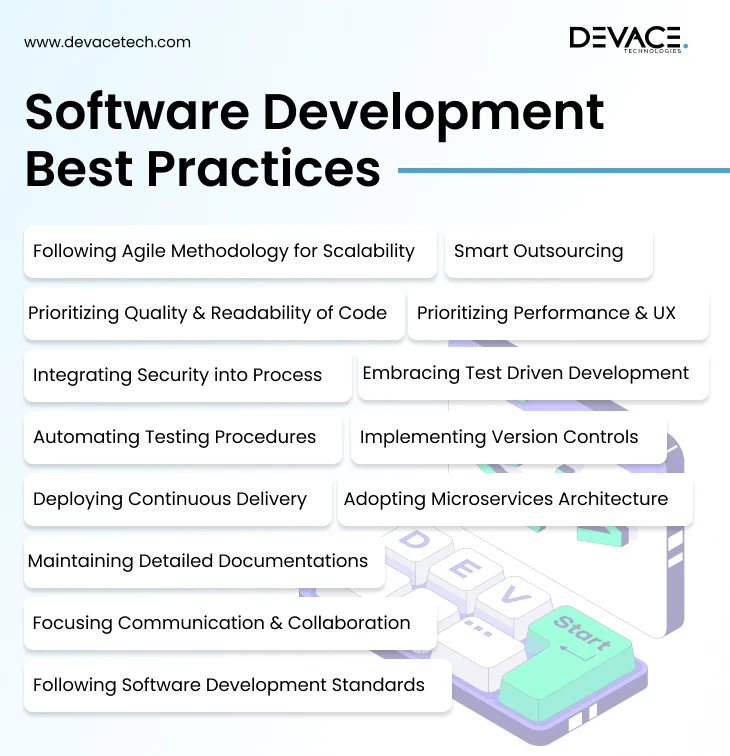If you are working on software development in 2025, you can follow certain best practices that empower you to build dynamic software. Individual developers and teams can opt for these strategies to carry out smooth development. In this blog, we will learn about the top 13 software development practices that are trending in 2025.
What are the Software Development Best Practices in 2025?
A pre-tested set of development methodologies, guidelines, and principles can be collectively adopted as software development best practices to design high-quality software. With these practices, developers become able to identify and write clean, efficient, and maintainable code. Moreover, they can improve user experience and team collaboration and reduce risks during web development.
13 Software Development Best Practices to Adopt
Here we are explaining the 13 best software development practices including Agile methodology, prioritizing code quality and reusability, integrating security, smart outsourcing, and others.

1. Following Agile Methodology for Scalability
Adopting Agile methodologies is a popular approach among developers. It enables teams to divide their projects into small, manageable parts, facilitating the development process. The Agile software development lifecycle allows teams to quickly adopt changes in requirements with the help of continuous feedback, short sprints, and regular review sessions.
Agile Methodologies:
Some key Agile methodologies include:
- Scrum: Targeting small increments of delivery.
- Kanban: Basically, a fluid approach emphasizing visualizing tasks.
- Extreme Programming: Focusing on frequent releases of operational software and technical excellence.
Moreover, by implementing these strategies, web developers can ensure rapid delivery times, improve product quality, and facilitate collaboration.
2. Prioritizing Quality & Readability of Code
For a web project to be scalable, reliable, and maintainable, code quality is of prime importance, and it becomes even more important with the project growth. Moreover, if you write clean, easily readable, and well-documented cod,e it facilitates other developers to maintain, extend, and understand software.
Best Practices to Maintain Code Quality:
- Following software development standards and best practices.
- Conducting regular code reviews for early bug detection, promoting knowledge sharing, and improving quality.
- Deploying unit and integration testing for catching bugs early.
3. Integrating Security into the Process
Security should be integrated from the very early stages of software development, and it should not be an afterthought. It’s essential due to prevailing cyber threats. Security integration includes adhering to best security practices in encryption and data protection.
Best Security Practices:
- Incorporating Open Web Application Security Project guidelines.
- Opting for secure coding practices to ensure software development security.
- Carrying out regular penetration tests and security audits to identify vulnerabilities.
4. Automating Testing Procedures
Another approach among the best practices of software development is automating different testing procedures. In this way, by improving accuracy you can speed up the development process. Testing automation assists developers in identifying issues and reducing risks of errors. Moreover, you can hire dedicated software developers to seamlessly automate app testing.
Automation Tools:
You can use these automation tools to ease development:
- JUnit for conducting unit testing in Java applications.
- Selenium for task automation in web applications.
- Cypress to do end-to-end testing in apps.
Are you facing any difficulties in the software development process?
5. Deploying Continuous Delivery
With continuous delivery, you can automatically design, test, and prepare code for production. In this way, updates can be made by avoiding errors and this can be done just with minimal downtime. In the case of continuous deployment, you go a step further, deploying changes to production automatically. Also, companies can hire remote developers to release software more reliably and frequently.
Some Key Advantages:
By following continuous delivery or continuous deployment, you can have certain benefits including:
- Rapid release of bug fixes and modern features.
- Premium quality software can be made through automated testing.
- Minimized downtime due to efficient and seamless deployment.
6. Maintaining Detailed Documentation
To maintain and scale up software projects proper documentation is essential. New developers can work speedily if already documented code and processes are available. It also results in better communication among stakeholders allowing better troubleshooting.
Some important types of documentation include:
- Code documentation with explanations and comments inside the code.
- API documentation packed with essential information on how to work with the app API.
- Clear instructions in the form of guides and user manuals.
Moreover, keep in mind that you should always consider good documentation as an essential part of the software development lifecycle.
7. Focusing Con ommunication & Collaboration
Collaboration is crucial in modern software development. To ensure that the software is compatible with business requirements, developers need to work and collaborate with designers, stakeholders, testers, and other team members.
Practices for Collaboration:
- Holding brief daily standups to discuss progress, next steps, and blockers.
- Pair programming for developers by working on the same code, promoting quality and knowledge sharing.
- Making cross-functional teams with UX designers, product owners, developers, and testers on board.
Also, faster problem-solving, better decision-making, and a cohesive development process can be ensured with effective communication.
8. Prioritizing Performance & UX
For a successful software user experience is one of the most important factors. Users can get a more satisfying experience with your software if you emphasize smooth interactions, quick load times, and intuitive interfaces.
Best UX Practices:
The UX practices given are among the best practices in software development:
- Making a user-friendly design by focusing on the goals, behavior, and needs of users.
- Regular performance optimization to minimize loading time.
- Ensuring the accessibility of software.
With good user experience users keep on coming back resulting in higher conversion rates and success. Moreover, you can consult a software development company to offer a great user experience.
9. Following Software Development Standards
By following software development standards, you can maintain the security, quality, and consistency of projects. Such standards offer detailed guidelines for documentation, design, testing, and implementation of software.
Top Software Development Standards
- ISO/IEC 12207 standard for the software development lifecycle.
- ISO/IEC 27001 is an international standard for security management.
- IEEE 829 software standard for testing software documentation.
10. Smart Outsourcing
Software development outsourcing can provide you with specialized skills, lower costs, and scale up your development team quickly. However, to avoid challenges associated with outsourcing, you should choose the right service provider.
Some Best Outsourcing Practices:
You can follow the given outsourcing practices to develop successful software:
- Partnering with a company that has a proven track record of providing high-quality solutions.
- Defining clear project timelines, deliverables, and goals to avoid misunderstanding.
- Maintaining smooth collaboration with the help of tools such as Slack, Zoom, and Jira.
If done properly, outsourcing can significantly scale your development process.
11. Implementing Version Controls
Managing codebase changes by version control is a popular practice. With this practice, developers can track changes, revert to the old version of the code if required, and collaborate effectively. For version control, multiple tools such as GitHub, Git, and Bitbucket are used.
12. Embracing Test-Driven Development
Through this practice, developers write tests before writing code. It’s a great approach to ensure that your written code behaves according to expectations. The test-driven development comprises writing a test, followed by running the test, which should fail at the start, and then writing the code to pass that pre-written test.
Advantages of Test-Driven Development
Some key advantages of opting for test-driven development of software include:
- Functional compatibility of code.
- Minimizing the chances of bugs because tests are written before deployment.
- Code becomes modular, and it is easier to refactor.
Moreover, you can reduce the number of defects and improve the reliability of software by adopting this test-driven methodology.
13. Adopting Microservices Architecture
In a microservice architecture, software is built as a collection of loosely attached independent services. Out of these, each service emphasizes a particular business capability and can be scaled, developed, and implemented independently without affecting other services. Moreover, you can hire remote programmers who can facilitate development.
Some Key Benefits of Microservices
- Enable independent and faster implementation of services.
- Improve flexibility by allowing the scaling of individual services.
- Enhance fault tolerance.
Wrapping Up
With the emergence of new technologies and methodologies in 2025, some key software development practices are popular among developers. They can design secure, high-quality, and dynamic applications by adopting software development best practices. From following agile methodologies to opting for microservices architecture these approaches offer a roadmap for successful software development.
Are you worried about your upcoming software development process?
Frequently Asked Questions
What are the best software development practices in 2025?
In 2025, the best software development practices include agile methodologies, security integration, prioritizing code quality and readability, and testing automation. It also includes the implementation of version control, adopting test-driven development, and microservice architecture.
How can I benefit from Agile in software development?
With agile you can improve scalability, offer continuous feedback, and other development stuff, enabling teams to adjust to any change rapidly and efficiently design software.
What are the basic best practices for development teams while downloading open-source software?
Developers should verify and download those repositories that are official, like GitHub or npm. Ensure license compatibility with your project, evaluate community activity, and review code for critical apps in terms of security. Also, scan for vulnerabilities and track and automate updates.
What are the best practices for using AI in software?
For using AI in the software development process. You can start by identifying the problem that AI is going to solve. Use clean and relevant databases to get code, test for accuracy, fairness, and bias, and stay updated in case of changes. Also, you can regularly review performance.
Why does software development practice matter?
Software development practices are essential for writing and maintaining clean and readable code. Adopting the best development practices is essential for reducing potential cyber threats and vulnerabilities, ensuring team consistency, and enhancing scalability.

